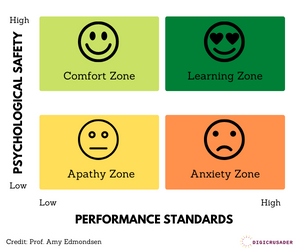Did you know that Issues related to psychological safety cost large firms MILLIONS of dollars each year?
Despite that, it is still one of the least understood aspect amongst leaders at work and the fact that we are operating in a remote virtual working environment is further amplifying the scale and impact of these issues.
Psychological safety at work is one of the most important aspects for leaders to consider. It plays out in very subtle ways initially which may be difficult to notice and eventually spirals into situations which are more dire, impacting individuals and teams.
Consider how the below situation is playing out in a virtual team meeting:
Manager — “Today we are going to talk about this project, and this is how I am thinking we can go about accomplishing our goal.”
Team — “” (Silence)
Manager — “Any questions?”
Team — “” (Silence)
Manager — “Great! Let’s go for it then.”
To a manager this may seem like there is good alignment within the team, and they have been able to mobilize the team towards the goal, but this may be a typical sign of a defect running within the team. I call it a defect as it can create dysfunctional teams which are not able to meet the goals, or operate in comfort zone vs striving for excellence.
So what is Psychological Safety?
Psychological Safety is a shared belief held by members of a team that others on the team will not embarrass, reject, or punish you for speaking up. A psychologically safe workplace begins with a feeling of belonging. Like Maslow’s hierarchy of needs — which shows that all humans require their basic needs to be met before they can reach their full potential — employees must feel accepted before they’re able to improve their organizations.
I have noticed many a times, that there is a great deal of confusion amongst managers when it comes to psychological safety. Edmondson, a leader in the field of psychological safety, goes on to say that it is not a trade-off against accountability but rather they are two separate dimensions. Leaders who create psychological safety and hold their employees accountable for excellence are the highest performing. According to Edmondson, it is all about finding the balance, as illustrated in the image below.

If both psychological safety and accountability are missing, people become apathetic and simply do what they need to do, without questioning anything nor striving for excellence.
If there is only psychological safety, people operate in a comfort zone where it is easier for people to raise their concern, but without accountability it can result in people feeling too comfortable and hence leading to low performance.
If we hold people accountable without creating an environment of psychological safety, it can lead to stress and anxiety, which will not be a conducive place for growth.
When both accountability and psychological safety are present together, it creates a learning zone for the team — a zone where the team feels free to challenge, and also owns the results — thus leading to high performance!
Building Psychological Safety at Workplace – The Magic Formula
So how can leaders create this environment where psychological safety and accountability exist together? Am glad you asked. 😊
Having observed many leaders across different sectors and geographies, I found these 5 traits running common across high performance teams which were able to create a constant learning environment and strived for results. I call this “B-R-A-V-E”, the success formula for high performance teams. Let’s explore further the 5 traits which make this formula a powerful concoction for leaders to create high performance teams.

Become a Role Model for the team
Every leader needs to role model the behaviors which they want to embed within their teams. And it start with a deeper awareness of self. Also in order to create a learning environment for the team where they can open up about their feelings and thoughts, the leaders need to embrace vulnerability. Additionally, there are many biases which may creep in, as we operate with remote teams these days and a leader must be aware so can spot and address them.
Rollout Tenets for a Safe Space at Work
One of the secrets of successful organizations and teams is that they are able to define a culture and way of working, by establishing certain tenets for the team which everyone in the team embraces and is expected to demonstrate everyday. Be it the leadership principles of Amazon or Core values at Google, all of these essential building blocks of the companies and teams.
As a leader, to create a learning zone, where both psychological safety and accountability are encouraged, it is necessary to call out the tenets for the team (like “Challenge the Idea, Not the Person” being one of the most effective ones to create a learning space), which will inspire and encourage the teams to live those behaviors which create a tailwind for the desired culture to thrive.
Advocate Inclusivity & Encourage Dialogue
A leader must be an advocate of Inclusivity within teams. Stated simply, it is about providing equal access to opportunities and a safe space for everyone to speak up without the fear of judgement. Leaders must also encourage dialogue within the team, by being aware of different personality types and creating a space where everyone can contribute. For example, if there are some people within team who take time to process information, a leader can benefit from providing time for those people to contribute and not make hasty decisions where they may feel excluded.
Vouch for a Learning Culture
One of the things which I have seen high performance teams do is that they consider mistakes as a way of learning. They have an environment in which healthy debate is encouraged, people are free to challenge without fear of judgement, people take risks but hold themselves equally accountable to results, people constantly share and learn from each other. It’s like a symphony of perfect notes playing together, to create a magical outcome.
“Failure and invention are inseparable twins. To invent you have to experiment, and if you know in advance that it’s going to work, it’s not an experiment.”Jeff Bezos, Amazon
Tweet
Elevate Feedback and Coaching
This is one of the most important traits I have seen in leaders who create a thriving high performance culture. They are able to provide very effective feedback and operate more as coaches for their teams to own their performance.
Feedback — Leaders of high performance teams operate with a radical candor. Radical candor is the ability to challenge directly and care personally at the same time. These leaders are able to challenge directly, while providing SBI (Situation-Behavior-Impact) feedback, which builds in more objectivity and helps the team in identifying areas of improvement.
Coaching — Leaders of high performance teams also lean on Coaching. Coaches. They are able to step back and stay curious about their teams, and hence able to connect at a deeper level and inspire the team to act and own their decisions. The GROW model is one of the most popular coaching frameworks. This framework for coaching was developed in the 1980s by Sir John Whitmore and his colleagues at Performance Consultants International. Seeking to find a more effective way to lead in business, GROW was developed to create stronger leaders.
GROW is an acronym for the following components:
· Goal (Aspirations)
· Reality (Current obstacles or Situation)
· Options (Ideas)
· Way forward (What, when, by whom, and the will to do it)
Benefits of Creating Psychological Safety at Workplace
Creating psychological safety in the workplace has numerous benefits for both employees and the organization as a whole. Here are some of the key benefits of creating a psychologically safe work environment:
- Increased creativity and innovation: When employees feel safe to express their ideas and opinions without fear of negative consequences, they are more likely to contribute their unique perspectives and insights. This can lead to greater creativity, innovation, and problem-solving within the organization.
- Improved collaboration and teamwork: When employees feel safe to speak up and share their thoughts and concerns, they are more likely to work together effectively and build stronger working relationships. This can lead to increased collaboration, better teamwork, and improved performance outcomes.
- Greater job satisfaction and engagement: When employees feel safe and supported at work, they are more likely to feel satisfied with their job and engaged in their work. This can lead to improved productivity, lower turnover rates, and a positive work culture.
- Increased trust and respect: When employees feel safe to express themselves and are treated with respect and understanding, they are more likely to trust their colleagues and management. This can lead to greater loyalty, better relationships, and a more positive work environment.
- Reduced stress and anxiety: When employees feel psychologically safe, they are less likely to experience stress and anxiety related to work. This can lead to improved mental health and well-being, as well as better physical health outcomes.
- Improved performance and productivity: When employees feel safe to take risks and make mistakes, they are more likely to take initiative and demonstrate leadership qualities. This can lead to improved performance outcomes and increased productivity within the organization.
Summary – Creating Psychological Safety at Workplace
Summing up, if the leaders are able to effectively incorporate these 5 traits (B-R-A-V-E) mentioned above, they will be able to harness the power of it all coming together to create an environment where Psychological safety and Accountability can exist together and create a thriving environment for high performance teams.
I have written a detailed article on Leadership Concepts distilled from my experience of working with 100s of global CEOs, which you can use to Supercharge your Leadership Impact.












1 Comment